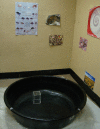Age sensitivity of behavioral tests and brain substrates of normal aging in mice
- PMID: 21647305
- PMCID: PMC3103996
- DOI: 10.3389/fnagi.2011.00009
Age sensitivity of behavioral tests and brain substrates of normal aging in mice
Abstract
Knowledge of age sensitivity, the capacity of a behavioral test to reliably detect age-related changes, has utility in the design of experiments to elucidate processes of normal aging. We review the application of these tests in studies of normal aging and compare and contrast the age sensitivity of the Barnes maze, eyeblink classical conditioning, fear conditioning, Morris water maze, and rotorod. These tests have all been implemented to assess normal age-related changes in learning and memory in rodents, which generalize in many cases to age-related changes in learning and memory in all mammals, including humans. Behavioral assessments are a valuable means to measure functional outcomes of neuroscientific studies of aging. Highlighted in this review are the attributes and limitations of these measures in mice in the context of age sensitivity and processes of brain aging. Attributes of these tests include reliability and validity as assessments of learning and memory, well-defined neural substrates, and sensitivity to neural and pharmacological manipulations and disruptions. These tests engage the hippocampus and/or the cerebellum, two structures centrally involved in learning and memory that undergo functional and anatomical changes in normal aging. A test that is less well represented in studies of normal aging, the context pre-exposure facilitation effect (CPFE) in fear conditioning, is described as a method to increase sensitivity of contextual fear conditioning to changes in the hippocampus. Recommendations for increasing the age sensitivity of all measures of normal aging in mice are included, as well as a discussion of the potential of the under-studied CPFE to advance understanding of subtle hippocampus-mediated phenomena.
Keywords: Barnes maze; Morris water maze; cerebellum; context pre-exposure facilitation effect; eyeblink classical conditioning; fear conditioning; hippocampus; rotorod.
Figures





References
-
- Aguilar-Valles A., Sanchez E., de Gortari P., Balderas I., Ramirez-Amaya V., Bermudez-Rattoni F., Joseph-Bravo P. (2005). Analysis of the stress response in rats trained in the water-maze: differential expression of corticotropin-releasing hormone, CRH-R1, glucocorticoid receptors and brain-derived neurotrophic factor in limbic regions. Neuroendocrinology 82, 306–31910.1159/000093129 - DOI - PubMed
-
- Ambrée O., Richter H., Sachser N., Lewejohann L., Dere E., de Souza Silva M. A., Herring A., Keyvani K., Paulus W., Schäbitz W. R. (2009). Levodopa ameliorates learning and memory deficits in a murine model of Alzheimer's disease. Neurobiol. Aging 30, 1192–1204 - PubMed
-
- Anderson B., Gunderson H., Pakkenberg B. (2003). Aging of the human cerebellum: a stereological study. J. Comp. Neurol. 466, 356–365 - PubMed
Grants and funding
LinkOut - more resources
Full Text Sources

